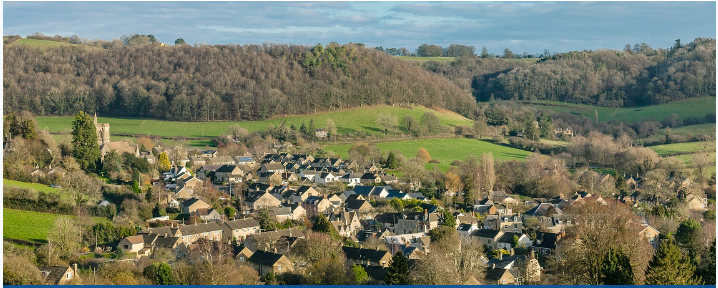
History
We provide a brief history of the village of Uley and the neighbouring hamlet of Owlpen because it helps to explain why the settlements have evolved to their present shape and character. Anyone wishing to learn more about the history of Uley and Owlpen is advised to consult the excellent book written by Alan Bebbington [i].
Uley and Owlpen are tucked into a sheltered valley lying behind the steep Cotswold escarpment that defines the eastern boundary of the Severn Vale. The river Ewelme flowing through the valley, fed by abundant springs, combined with the topography and geology of the area have all contributed to the history of the settlement, providing shelter, grazing, water, timber, stone and fuller’s earth.
There are signs of occupation in Neolithic times in the standing stones and chambered long barrow or burial chamber known as Hetty Pegler’s Tump. Uley Bury was the site of an Iron Age fort and in the first century AD became an important strategic Roman encampment. A fine head of Mercury dating from the second century, carved in classical style but in local stone, was excavated at West Hill, Uley, in 1979. It is now in the British Museum. When the Romans left in the fifth century the area became a Saxon camp.
Sheep farming and the wool trade gradually gave way to wool processing and cloth manufacture as the main industry of the area and the villages of Uley and Owlpen grew considerably. Increasing prosperity in the seventeenth and eighteenth centuries led to the replacement of the predominantly timber dwellings with houses built of locally quarried stone and these created the structure of Uley as it is today. Uley is mentioned in the Domesday Book (1085 AD) as part of the Berkeley Hundred. In Elizabethan times the Manor of Uley was bought out from the Berkeleys by a group of thirteen residents, which gave the village a valuable degree of independence in years to come.
Both Uley and Owlpen were prominent in the manufacture of broadcloth for army uniforms during the Napoleonic wars. ‘Uley Blue’ cloth was internationally famous and wages were among the highest in England, which partly explains the proliferation of inns and public houses and diverse places of worship. Owlpen became a sizeable village with 240 inhabitants but when coal replaced water as the driving force for the great mills, the industrial revolution took wool processing north and by 1840 woollen manufacture had ceased in the valley, leading to much poverty and emigration to the colonies.
Owlpen was badly affected; the population and housing stock diminished considerably and Owlpen is now a scattered hamlet, although still having its own church. Agriculture and forestry were resurgent industries in the valley but the villages went through a long period of depression and stagnation until transport links and amenities improved following the First World War, enabling residents to travel further afield for employment.
The building of the nuclear power station and laboratories at Berkeley and improved motorway links in the sixties signalled the most recent change in the fortunes of the villages as Uley expanded to welcome a substantial number of new families.
[i] Alan Bebbington; A History of Uley Gloucestershire. Published by The Uley Society, February 2003 and usually available in the Uley Community Stores.